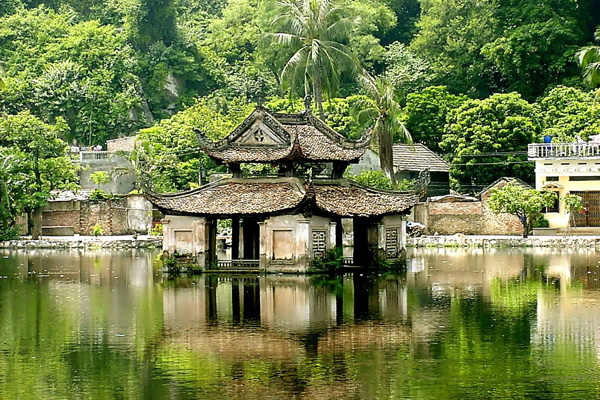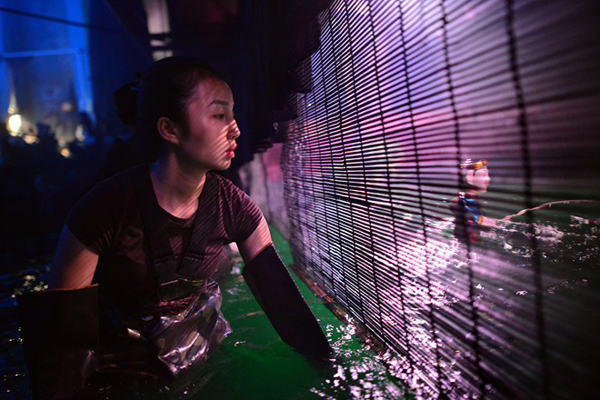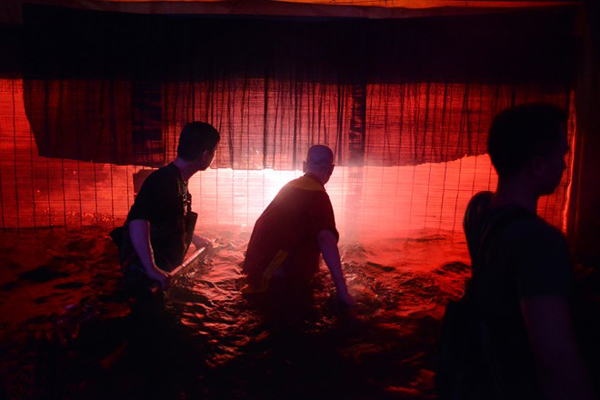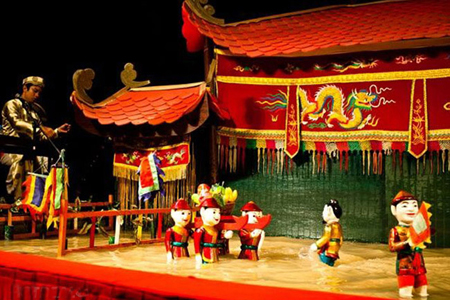This is the most remarkable part of the structure of a water puppet theatre and is the place from which the puppeteers control the characters. The manipulation room is about 36 square meters (6m x 6m) in area, with foundations sunk into the bottom of the pond or lake...
1. The Manipulation Room
This is the most remarkable part of the structure of a water puppet theatre and is the place from which the puppeteers control the characters. The manipulation room is about 36 square meters (6m x 6m) in area, with foundations sunk into the bottom of the pond or lake. The height from the water surface to the top of the roof is about 6 meters. There are two kinds of manipulation room - permanent ones and those for itinerant shows.
2. Waterside Pavilion at Thay Pagoda
The waterside pavilion at Thay pagoda is a typical manipulation room preserved virtually in the original form. The theatre was built out over the Long Tri lake in front of the pagoda itself. It has brick walls and a double roof with slipper-shaped tiles resting on a framework of wooden columns. Four main columns bear most of the weight of both upper and lower roofs. Twenty minor columns also share the weight of the lower roof.

The manipulation room is divided into three sections of different dimensions; the middle one is 2.92 m wide, while the lateral sections are narrower - one is 1.32 m and the other 1.25m. The floor of the middle section is 0.7m-1.1m under the water with a frontwards tilt of 8" so that the water in the manipulation room and that of the lake surface are contiguous. The floors of the lateral sections, about O.3m above the water, are the places where the musicians and director sit, where the artists can rest and where the puppets are kept.
3. Mobile Manipulation Room
Traveling guilds build temporary manipulation rooms similar in size and shape to those of permanent ones and made from wood, bamboo, and cloth. The eight sections of the two roof layers are painted to look like tiles. The manipulation room is divided not into three parts like a permanent one, but crosswise into front and back sections.
The floor in front is underwater and runs the whole width of the room, artists controlling their puppets while standing in water behind the screen. This horizontal arrangement makes it convenient for the puppeteers to move easily across the room (6 rn) without restriction, as in the case of a permanent manipulation room when the middle section is only 2.92 m wide. The rear functions like the lateral sections of a permanent manipulation room, with the area under the floor (above water) serving as a storeroom for puppets accessories and the place where the poles used to operate the puppets, are fitted. The manipulation rooms are the most important structure in a specialized form of theatre where control of the puppet is affected from behind the scenes. The puppets are made to gesticulate in front of the puppeteers in a manner similar to that of puppetry, but different from methods employing control from above (marionettes ... ) or from underneath (finger or rod puppetry).
4. The Stage
The "stage", the water surface in front of the manipulation room is regarded as a platform which is constantly moving due to the breeze and the actions of the puppets. In traditional Vietnamese water puppets, the stage has a gate, called a galloping horse, which is used during fire-cracker scenes and ground puppetry items that sometimes take place as interludes between water puppetry scenes. (This combination of water and ground puppetry no longer exists in most of today's water puppetry programs).

The show space is delineated by two rows of thin and low stakes alternating with flags which spring up when the show begins, or y two rows 0 puppets known as roi do which emerge from the manipulation room when the show begins and withdraw again at the end.
The traditional water puppet stage is' almost without decoration. Eight bamboo screens separating the manipulation room from the stage form the platform for the action. The effect is mainly achieved by means of the architecture of the manipulation room with the decorative designs on its roof and eight roof overhanging corners arched and curving upward. There have been changes over time in the traditional design of the stage. To expand the show floor performances, two a kind of lean-tot is built on both sides of the manipulation room, making the stage 2 meters wider. This form of the stage with the Nguyen guild (Thai Binh province) and has become a fairly common and enduring one. Various troupes use a stage with two nha nanh in show tours at home and abroad; they also serve as entrances and exits for the puppets.
The distance from the front to the back of the stage is generally about 10 meters, with the puppeteers often propelling the characters close to the edges. The puppets are able to dive under the water and then seemingly from nowhere emerge right in front of the audience, causing a great deal of amusement with their sudden appearance. In one scene, two buffaloes running amok chase each other beyond the limits of the stage, making the audience think they have stampeded, creating the impression of having witnessed a real buffalo-fight in the fields. In the scene "offering betel rolls" a number of village girls, each carrying a tray, skim across the water surface right up to the audience to offer them betel. These examples give an idea of methods and practices commonly used in Vietnamese folk theatre. Open and flexible, the show space allows the drama to unfold not only at the center but also in places far from the centre, even beyond the stage. The puppet characters, therefore, enjoy a wide natural setting as their back-drop. In fact, the performance space is actually larger than that available on a stage with props. In the old days, water puppet shows were held in the dazzy time so as to benefit from the natural light. The pond was also kept in its natural stage, only those bushes obstructing the audience's view were removed, while others were retained as stage props and hiding places for the puppets.

The audience could see tuffs of grass, water manioc, and even clumps of duckweed and water hyacinth floating around the puppets. The choice of whether to remove or retain natural elements depended on the individual viewpoint and aesthetic sense of the state manager. Unlike ordinary theatre, the design of a water puppet stage is not based on a prepared script, nor on the specific requirements of each scene or show. Every natural detail, once selected for use, has to remain on stage throughout the program. In the past, such practices stemmed from the fact that techniques were rudimentary and props could not be changed swiftly enough to suit the requirements of each scene.
The water's surface is in constant motion, absorbing every image, both of natural phenomena and of the puppet characters themselves. The movement of the stage is beyond the control of the artists. Since the water's surface is not a calm, stationary mirror passively reflecting any images received. With each such successive ripple. the images are further broken up or transformed, Changes in both form and color on the water stage increase the effect to a very great extent during the show. This could be considered a strong point. a special characteristic of a stage formed by water. quite unlike any other type of outdoor theatre. Firecrackers are used for aesthetic effect. creating brilliant colors which all of a sudden illuminate the stage through a fine veil of smoke. This technique helps to effect changes in light. The atmosphere and the unfolding drama on the stage. taking advantage of the light-sensitive nature of a stage formed by water.
5. The Audience Viewing Area
Sections of the edge of the pond or lake facing the stage and to the sides, about 10-15 m from the manipulation room, provide a viewing area for water puppetry audiences. A water puppet show is just one of the many entertainments which take place during a village festival, so villagers are free to choose the scenes they watch as well as the place from which to enjoy the shows.



